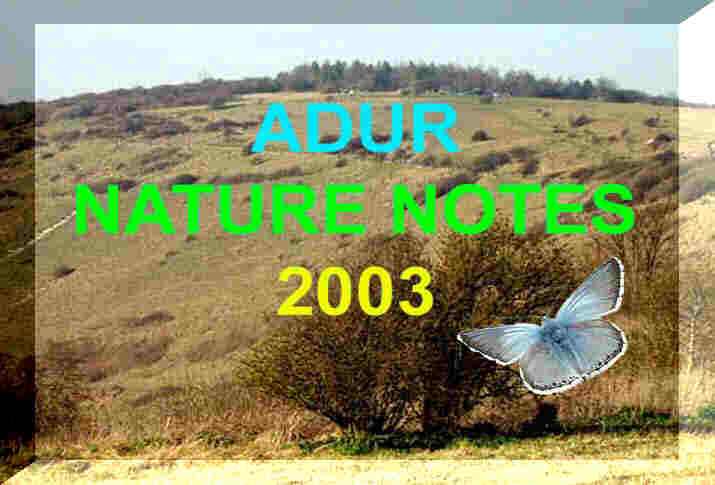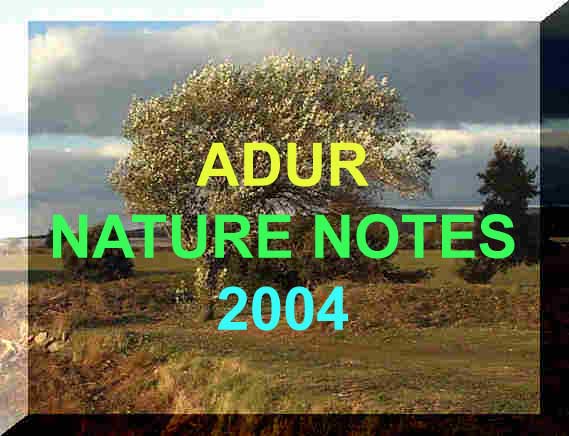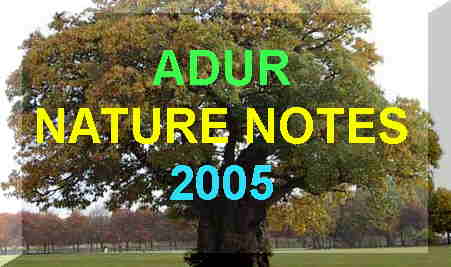including the Adur Levels, Mill Hill and cyclepath to Upper Beeding
Adur
Fungi 2006 Reports (Link)
| 14
December 2005
The small Candle Snuff Fungus, Xylaria sp., in the the designated footpath (between the Waterworks Road and the Steyning Road, Old Shoreham) have grown large enough to just about warrant a photograph. The precise species is not identified and is under enquiry. It does not appear to be Xylaria hypoxylon as it does not have the miniature deer antler appearance. It was in the middle of the path through the spinney of Field Maple and other small trees. |
 |
5 December
2005
Along
the Coombes Road a few large trees had been felled. The harmful Honey
Fungus was evident and on one heavily
lopped tree there was a bracket fungus
at least 60 cm in the diameter of its semi-circular appearance.
Adur
Levels 2005
 22
November 2005
22
November 2005
In
the Triangle area (middle slopes) of Mill
Hill there were over a dozen small mushrooms
called the Pale Wax Cap, Hygrocybe
berkeleyi, (known on the British
Mycological List as Hygrocybe pratensis var pallida)
near the seat. The largest had a cap diameter of 38 mm, and the tallest
was at least 50 mm high.
Adur
Hygrocybe
 |
 |
 |
 |
All
the fungi recorded had been seen before and those identifications are used
again for a dozen or so Golden Wax Caps,
Hygrocybe
chlorophana, discovered
on the A27 road
embankment (Mill Hill Cutting) just east of the bridge section where it
crosses the
Waterworks Road; a handful of
clumps of the small Dermoloma* mushrooms totalling about
a dozen on the Pixie Path approach to Mill
Hill from the Waterworks Road; a small Panaeolus
sphinctrinus amongst the grass (not
the dung as usual which was not observed) on Frampton's Field;and a large
intact species that I was so sure it was Volvariella
gloiocephala
that I did not inspect
it for its volva. This last one was on the edge of the meadow north of
the car park on Mill Hill. Its gills were brown.
*Later
(2014) the species
was thought to be the Crazed Cap, Dermoloma
cuneifolium.
7 November
2005
The
Sulphur
Tufts, Hypholoma fasciculare, from
Windlesham Gardens illustrated below begin to crack and show white lines
across their caps.
Adur
Sulphur Tufts
3 November
2005
 |
 |
 |
Sulphur Tufts
Sulphur Tuft, Hypholoma fasciculare, is such a common species of fungus that it only just about gets a mention. In these photographs of a clump on a tree stump in Windlesham Gardens, Shoreham, they are further developed (than shown below) and the stem ring can now be clearly seen.
 |
 |
 |
 |
Sulphur Tufts
After the rain the designated footpath (between the Waterworks Road and the Steyning Road, Old Shoreham) produced a two species of mushrooms growing in the soil amongst the leaf litter of Field Maple: Sulphur Tuft, Hypholoma sublateritium, with gills with a blue tinge and Sulphur Tuft, Hypholoma fasciculare, with a yellow tinge to its gills (although this would not reproduce in a photograph).
30
October 2005
On
the long grass verge island in The Drive, Shoreham, outside number 40,
there was a smallish Dryad's Saddle
(toadstool) amongst the grass with a large (about 15 cm) cap that had become
inverted. There was probably a root underneath as this large fungus usually
grows on wood, usually found on tree stumps of felled trees or rotten logs.
| 28
October 2005
The mushrooms on the right were discovered on the ridge of Mill Hill, before the steep drop on to the lower slopes. |
 |
 |
 |
| The first mushroom has a cap diameter of 18 mm and a height of 50 mm. It was found in short grass. | The second mushroom from the same area was substantially larger with a cap diameter of 40 mm, a thicker stem at a height of 45 mm. |
| 27
October 2005
The mushrooms on a rotten log on the the Coastal Link cyclepath near the first layby (from the south) on the Steyning Road had grown considerable larger after the recent rain and are illustrated by the photographs on the right. The suggested species is Agrocybe aegerita (= cylindracea). |
 |
 |
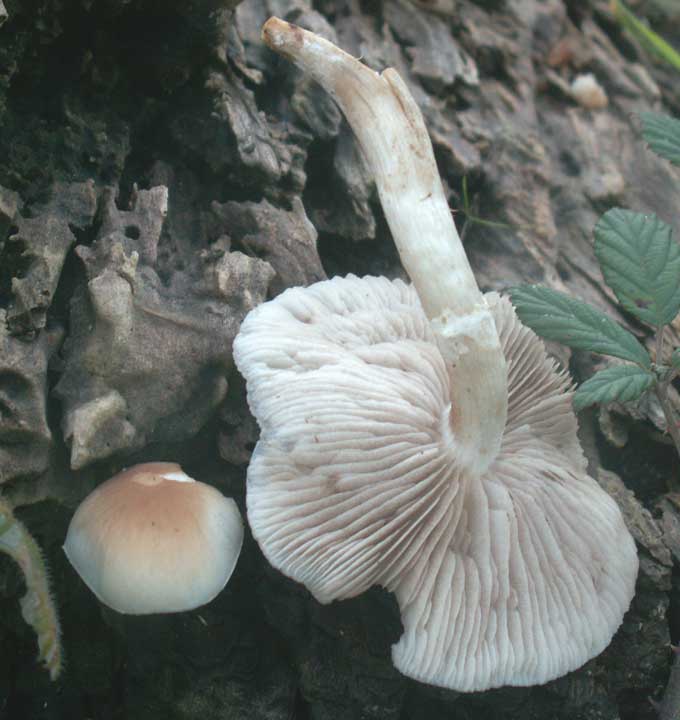 |
The
largest
mushroom measured 90 mm cap diameter with a curved stem that was at
least 120 m long. Although from the images it looks like they were surrounded
by grass, they were actually growing on a burnt
log.
| 25
October 2005
There were two Common Inkcaps in the Field Maple Spinney between the Steyning Road and the Waterworks Road, Old Shoreham. Shoreham Fungi 2005 The image shows one broken off and inverted. |
 |
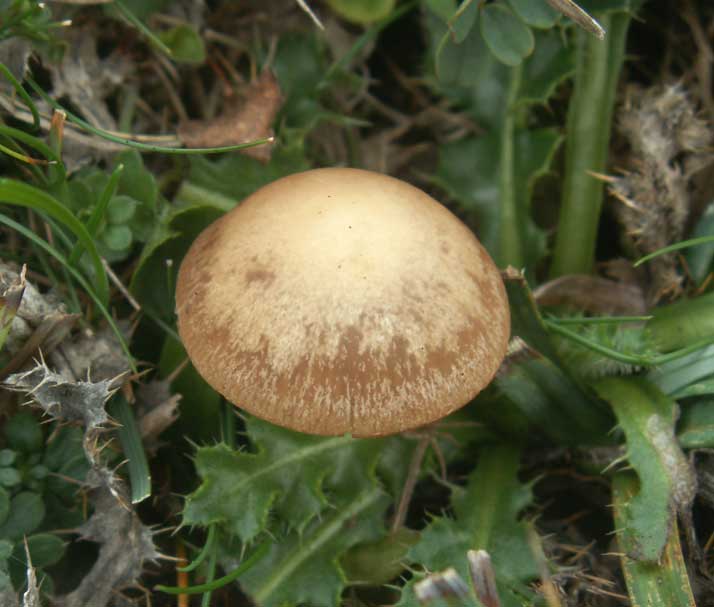 |
 |
 |
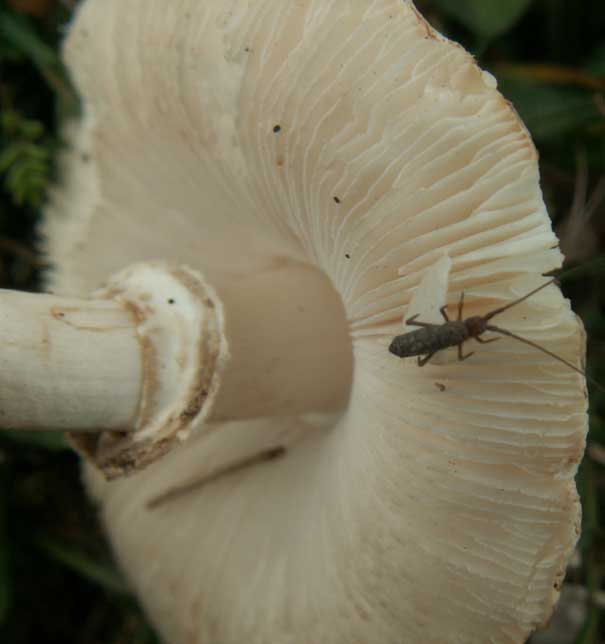 |
| This small mushroom had brown gills and a cap diameter measured at 17 mm. Its height was 38 mm with a white stem. It was growing amongst the short sward on the lower slopes of Mill Hill. | This
mushroom is the same individual fruiting body
as the one on the left.
This is probably a Psathyrella species. |
Although found in the short turf north of the Reservoir on Mill Hill, it was about the same size and appearance to the mushroom on the left. | White
Dapperling,
Leucoagaricus leucothites. from the lower slopes of Mill Hill. The small insect is assumed to be one of the springtails*. |
* Tomocerus longicornis
(ID suggestion by Paul Boswell
on the British
Beetles Yahoo Group.)
The
small white Candle-snuff Fungi
are now appearing.
22
October 2005
 |
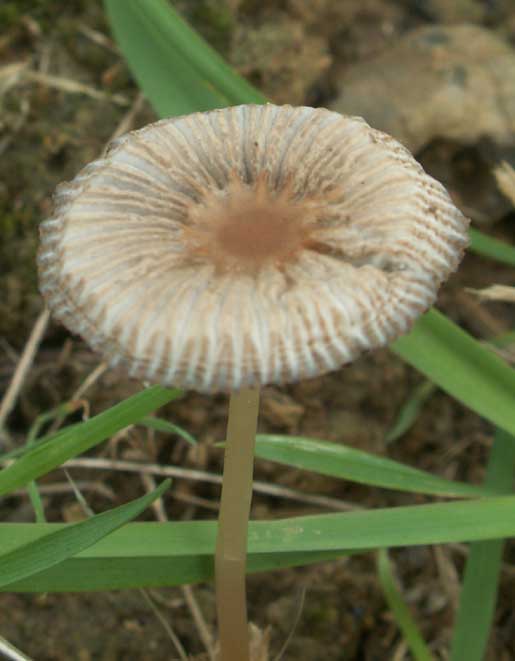 |
 |
 |
| This small mushroom had a cap diameter of 8 mm. It was growing with moss next to the mushroom below on the designated footpath (between the Waterworks Road and the Steyning Road, Old Shoreham). | This mushroom beside the verge of the Steyning Road (near Old Shoreham) was brittle and its stem broke very easily. | With a similar brittleness, the mushroom was probably a fresher version of the the one on the left. Its cap diameter was measured at 30 mm and height estimated at 65 mm. It was probably growing in soil. | This
small fungus was growing on a rotten log on the the Coastal
Link cyclepath near the first layby (from the south) on the Steyning
Road. Its cap diameter was estimated at 12 mm.
I think this is the Honey Fungus. |
20
October 2005
 |
 |
The
designated footpath (between the Waterworks
Road and the Steyning Road, Old Shoreham) produced a two mushrooms
growing
in the soil amongst the leaf litter of Field
Maple. I have tentatively identified this
species as the Rooting Shank,
Oudemansiella
radicata. The stem was quite strong
and could not be broken easily, although one of the mushrooms was easily
uprooted. The height of the fungus was measured at 90 mm and the cap diameter
as 50 mm.
Link
to an Image showing the rooting attachment
Adur
Levels 2005
14
October 2005
 |
 |
There were over a dozen large Agaricus mushrooms growing under a ? tree in Southdown Road, Shoreham. They looked edible. The cap diameters of two of the opened up mushrooms were measured at 60 mm and 70 mm. These mushrooms deliquesced very quickly and two stored specimens were inedible the following day. These are probably the edible Field Mushroom, Agaricus campestris.
9 October
2005
 |
 |
A half
a dozen fresh Shaggy Parasol Mushrooms,
Macrolepiota
rhacodes, were growing amongst a pile of leaves in the twitten
between Corbyn Crescent and Adelaide Square, Shoreham,
on the edge of the Middle Road allotments. Their average cap diameter was
a measured 73 mm and their height was over 100 mm.
Shoreham
Urban Wildlife 2005
13
September 2005
On
the large pile of horse dung in Frampton's Field
(north of The Street, Old Shoreham) there was a large number of mushrooms.
 |
 |
They looked like Panaeolus sphinctrinus to my inexperienced eye.
4 September
2005
There
was Honey Fungus Mushrooms
(a pest species of trees) on the Hawthorn
scrub
immediately to the north of the lower slopes
of Mill Hill.
1 September 2005
3 August 2005
This small mushroom was found on the grass on the shingle near Old Fort. The photograph is probably not good enough for identification. The cap is about 25 mm in diameter. I neglected to measure the long stem of about 100 mm. It could be a Coprinus, one of the Ink Caps?

